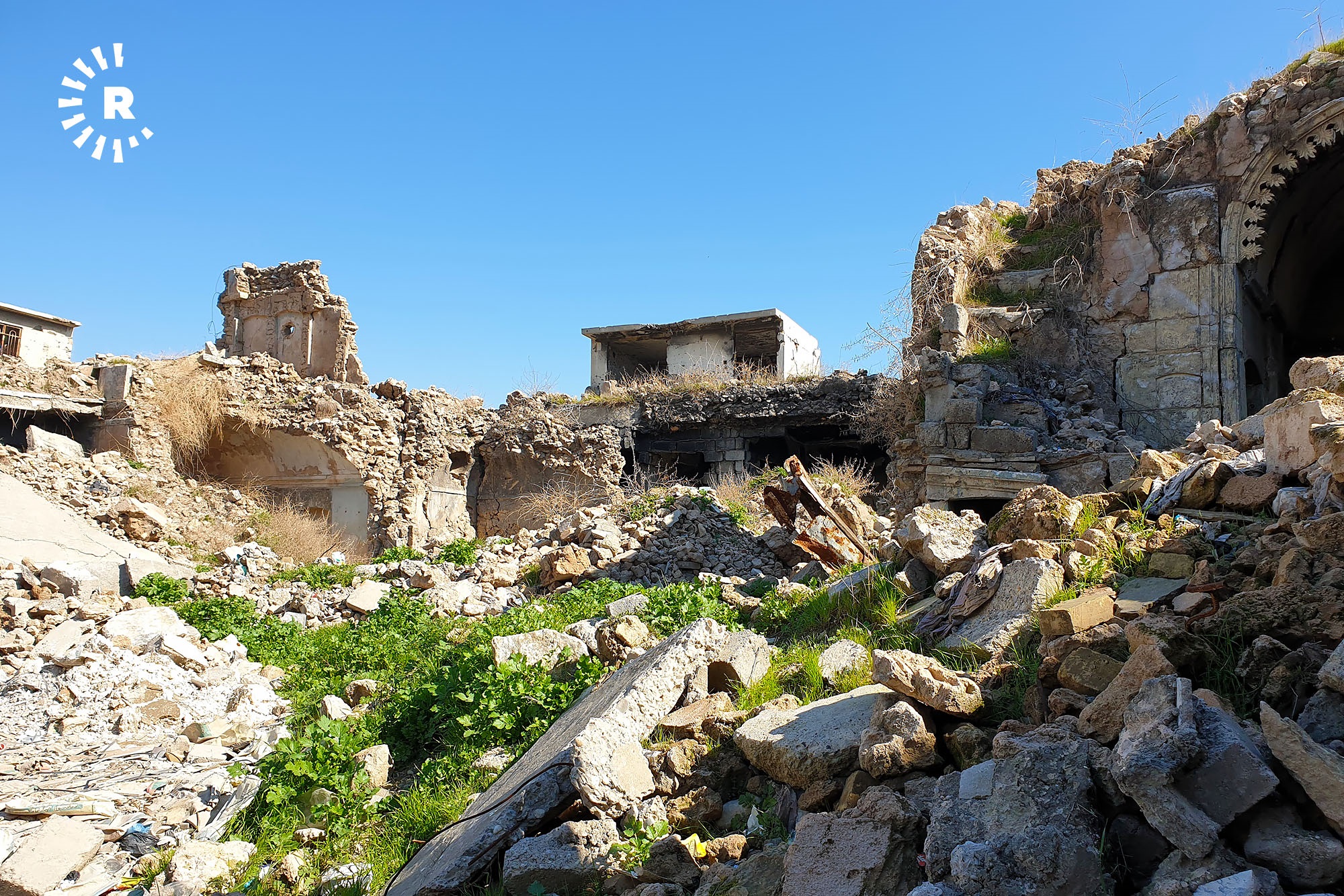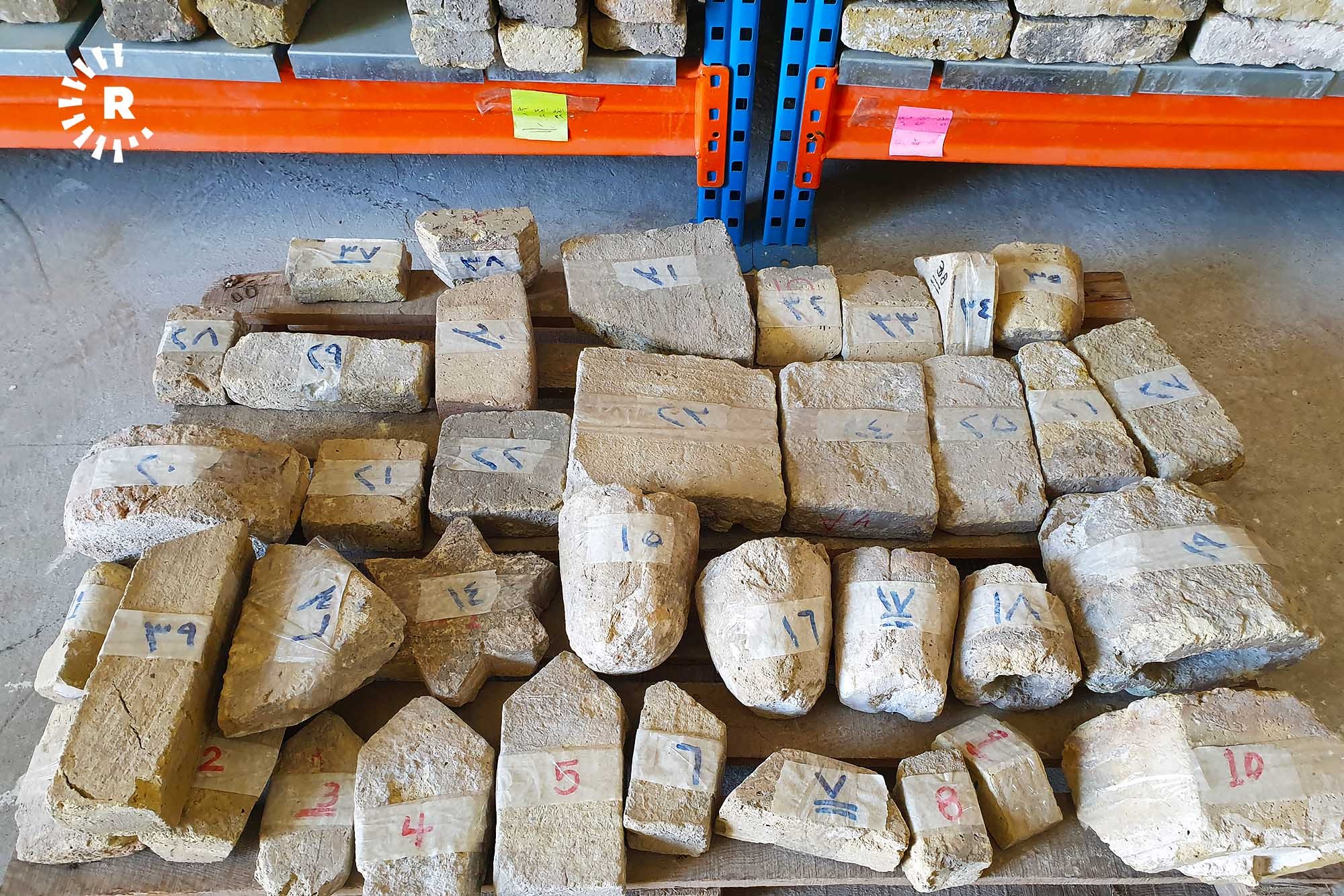
View of the fenced off al-Nuri Mosque and its complex on February 23, 2021, as seen from the window frame of a building destroyed during the battle of Mosul. Photo: Khazan Jangiz / Rudaw
MOSUL, Iraq – What used to be an apartment, a home, is now part of what is barely a building. A message is spray-painted on the bullet-ridden wall: “Don’t demolish the apartment because it’s sound, thank you”. It is true – compared to any other building in west Mosul’s Old City, it is sound.
As you walk through the Old City neighborhood, you are surrounded by piles of rubble, torn down roofs, and scorched walls. But what is left of the walls speak to you as you move past them, reading off scripts written in the colors of the Iraqi flag; “we want a peaceful country” in red; “freedom” in green; “I want my rights” in black.
The scars of the oppressive rule of the Islamic State (ISIS) and the war with it that followed in Mosul cut deep, and are unlikely to heal soon. But what is seeing repair – slowly but surely – are its landmark buildings, their reconstruction soundtracked by the sound of hammers, drills and shovels being put to work.
In the Old City is Jami al-Kabir (Great Mosque) Street, where al-Nuri Mosque stands. It once held a symbolic significance for ISIS, because it was where their leader, Abu Bakr al-Baghdadi, declared the establishment of the caliphate in 2014, following the ISIS occupation of Mosul.
The mosque and its leaning al-Hadba ("hunchback") minaret, which stood at 45 meters tall, were built in 1172 and became iconic Mosul landmarks. Both were destroyed during the battle of Mosul in 2017, two of more than 40 historically valuable buildings were either destroyed or completely torn down during ISIS rule and the war that followed.
ISIS was expelled from the city by the Iraqi security forces and its allies in July 2017. From then on, the city could begin its long and difficult journey on the road to recovery.

Revive the Spirit of Mosul is an initiative launched by UNESCO in February 2018. Funded by the United Arab Emirates and the European Union, among others, it works towards reviving landmark cultural and religious sites like the mosque and its minaret and the al-Saa’a and al-Tahira churches.
The first stage of the reconstruction of al-Nuri mosque began in February 2019, with around 5,600 tons of rubble removed from the site. Reconstruction is now in its second stage, said Omer Taqa, a contract engineer and Mosul native at the scene. Close to the mosque, ten historical houses that were destroyed during the war with ISIS are also being restored.
“The first difficulty that we faced was with the rubble removal, because the site was unsafe – we found about 20 IEDs, some of them yet to have exploded,” Taqa said. “ISIS also put some of them inside the walls of the prayer hall, because the wall is one meter thick.”
Seven IEDs were found inside the mosque’s prayer hall walls, all of which were removed without causing any damage.

In a warehouse on the 12,000 square meter site, 39 stones of different shapes and sizes that once formed part of the mosque and minaret have been preserved. Around 40,000 stones have been kept to be reused later for reconstruction, to rebuild the mosque and minaret the way Mosulites want them rebuilt.
Earlier this month, UNESCO shared the results of a survey it conducted with the Statistics Consultancy Bureau (SCB) of the University of Mosul. More than 700 Mosulites from both sides of the Tigris river, as well people displaced from the city, were asked how they would like to see the al-Hadba Minaret and al-Nuri Mosque’s prayer hall rebuilt.
The results were emphatic. Ninety-four percent of respondents said they would prefer that the Minaret be positioned and decorated as it was before its destruction in 2017. Seventy percent of respondents said they wanted the prayer hall to be rebuilt as it was in 2017 with some improvements, provided that “the essence and main values are preserved”. Just under thirty percent preferred that it be rebuilt exactly as it was in 2017.
Elsewhere in Mosul, life has inched back to normal. Despite coronavirus restrictions, the shopping streets of East Mosul are busy. In the city center, visitors, mostly Mosulites, take photos in front of the shrine of Nabi Yunus (Prophet Jonah), a revered religious site for centuries also brought to ruin during the reign of ISIS.
More than a million people from East and West Mosul were displaced by August 2017, and about 138,000 houses were damaged or destroyed during the conflict. Nearly four years after the city’s liberation, more than 300,000 people remain displaced, according to UN data from 2020.
As we walk back through the Old City, a woman takes a seat at the foundation four layers of brick high, the site where her old home used to sit overlooking the Tigris and where she is rebuilding her home once more.
“This used to be my house,” she says as we walk past her. “These used to be my neighbors,” she tells us, pointing to mounds of rubble.







Comments
Rudaw moderates all comments submitted on our website. We welcome comments which are relevant to the article and encourage further discussion about the issues that matter to you. We also welcome constructive criticism about Rudaw.
To be approved for publication, however, your comments must meet our community guidelines.
We will not tolerate the following: profanity, threats, personal attacks, vulgarity, abuse (such as sexism, racism, homophobia or xenophobia), or commercial or personal promotion.
Comments that do not meet our guidelines will be rejected. Comments are not edited – they are either approved or rejected.
Post a comment